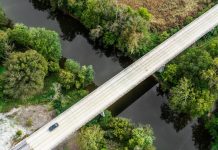Columbus is looking at the success of other Indiana and U.S. communities that have improved their riverfronts in hopes of attracting more local visitors and spurring economic activity in the city.
For more than a year, Columbus has been looking at improvements to its riverfront along the East Fork White River between the Second and Third Street bridges. The estimated $8.6 million project could provide recreational opportunities, connections to the People Trail system and overlooks of the river.
Before the city’s plans can move forward, however, Columbus must obtain the necessary permits from regulatory agencies such as the Indiana Department of Environmental Management, the Indiana Department of Natural Resources and the U.S. Army Corps of Engineers, city redevelopment director Heather Pope said.
But once the oversight obstacles are cleared, city leaders see multiple benefits with the project.
[sc:text-divider text-divider-title=”Story continues below gallery” ]
One is improving connections to the People Trail walking and bike path system, the area’s top tourism executive said.
Besides the healthy benefits of physical activity, an in-water recreational park with canoeing, inner-tubing and boogie boarding opportunities could also enhance the downtown as a destination — providing economic benefits, said Karen Niverson, executive director of the Columbus Area Visitors Center.
The visitors center anticipates the improvements could generate about $500,000 annually and bring nearly $1.2 million in economic activity throughout the community each year.
“Having the enhanced riverfront would make our downtown a more attractive destination,” Niverson said. “I talk with tourism colleagues around the state and get excited when I hear what they’re doing along their rivers, especially when I imagine how an enhanced riverfront will benefit our downtown.”
The city of Fort Wayne is developing a $20 million downtown Promenade Park that will be located on the St. Marys River. The project includes a pavilion, tree canopy trail, an amphitheatre and a band shell, among other amenities.
A grand opening is scheduled for summer, according to the Riverfront Fort Wayne website. The property will focus on water activities and recreational opportunities that rivers in the area provide, the website said.
DNR changes
Columbus is currently navigating the approval process with regulatory agencies such as the Department of Natural Resources to make needed changes, said Randy Royer, principal with Hitchcock Design Group of Naperville, Illinois, which was hired to develop conceptual designs for the city’s proposed riverfront.
In-water structures that had been originally proposed to hold up water have been among the topics of discussion. The state agency has expressed concerns about grout and unsuitable soil conditions, Royer said.
The amount of grout that would be needed to hold the structures together was unacceptable to the DNR, Royer said, something that Hitchcock and the city are working through.
In addition, the DNR requested that a planned trail be established on higher ground to minimize the impact on the river, Pope said.
“Our bottom line is to improve the safety of the river,” Pope said. “Those conversations continue until we come to a mutual agreement.”
Pope said Columbus wants to ensure the river will be safe and that there are recreational opportunities available.
While the permitting process is taking longer than anticipated, Pope said an improved riverfront will be beneficial to the community as a whole.
City objectives
One of the city’s safety objectives is removal of the low-head dam, while also addressing erosion on both sides of the river, Mayor Jim Lienhoop said.
With overlooks part of the Columbus Riverfront plans being considered, beautification of the area also remains a focus, in addition to enhancing tourism, he said.
“When you have an attractive body of water, it attracts people to it,” Lienhoop said.
Lienhoop said the city has applied for grants that would be used for the riverfront project, while additional funding would come from the Columbus Redevelopment Commission. He added that the city may seek external funding depending on how much might be needed, but that hasn’t been determined yet.
[sc:pullout-title pullout-title=”What’s next” ][sc:pullout-text-begin]
The city of Columbus is currently working with regulatory agencies to obtain the necessary permits required before work can begin on the Columbus Riverfront project.
[sc:pullout-text-end][sc:pullout-title pullout-title=”Pull Quote” ][sc:pullout-text-begin]
"I talk with tourism colleagues around the state and get excited when I hear what they’re doing along their rivers, especially when I imagine how an enhanced riverfront will benefit our downtown."
— Karen Niverson, executive director, Columbus Area Visitors Center
[sc:pullout-text-end]




